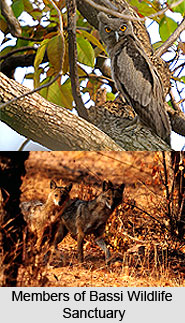 Bassi Wildlife Sanctuary is situated near Bassi region in the Chittorgarh district of the Indian state Rajasthan. It lies at a distance of 5 kilometres from Bassi Fort Palace on the western border of the Vindhyachal Ranges. It spans over an area of 15,290 hectares and includes Orai and Bassi dams as a part of the sanctuary. The sanctuary was established in the year 1988. Bassi Wildlife Sanctuary has a series of tableland along with gentle slopes and vast expanses of large lakes. Water channels are also there which penetrate into the forest. The lush green backdrop of the sanctuary makes it an ideal place for experiencing the beautiful nature.
Bassi Wildlife Sanctuary is situated near Bassi region in the Chittorgarh district of the Indian state Rajasthan. It lies at a distance of 5 kilometres from Bassi Fort Palace on the western border of the Vindhyachal Ranges. It spans over an area of 15,290 hectares and includes Orai and Bassi dams as a part of the sanctuary. The sanctuary was established in the year 1988. Bassi Wildlife Sanctuary has a series of tableland along with gentle slopes and vast expanses of large lakes. Water channels are also there which penetrate into the forest. The lush green backdrop of the sanctuary makes it an ideal place for experiencing the beautiful nature.
Flora and Fauna of Bassi Wildlife Sanctuary
A vast variety of flora and fauna are the inhabitants of this Bassi Wildlife Sanctuary. It is an excellent wildlife refuge where the animals dwell freely in their natural habitat without any human intervention and disturbances. Common species of fauna found here include Wild Boar, Mongoose, Leopard, Antelopes, Jackal, Crocodile, Civet, Spotted Deer, Panther, Porcupine, Langur, Blue Bull, Fox, Hare and many more. A number of exotic birds also flock around the sanctuary such as Rock Eagle Owl, Lesser Golden-backed Woodpecker, Black-headed Cuckoo-shrike, Asian Paradise-flycatcher, Painted Stork, Asian Openbill Stork, Sparrowhawk, Indian Peafowl and many others. During winters several migratory birds including Cranes and Pelicans, arrive from distant regions. Bassi Wildlife Sanctuary is a lesser known sanctuary and is a paradise for wildlife enthusiasts.
Visiting Information
For visiting Bassi Wildlife Sanctuary prior permission must be taken from the District Forest Officer, Chittorgarh. It is best visited during winters as during this season a number of magnificent winged guests can be spotted in the sanctuary. The sanctuary is well connected through roadways with neighbouring states. Rajasthan roadways (RSRTC) or private bus services can be availed by the tourists. Dabok Airport in Udaipur, situated at a distance of 70 kilometres, is the nearest airport which is connected to all the major cities of India. Chittaurgarh Railway Station located at a distance of 21 kilometres serves as the closest railway station. Boating and angling activities can also be cherished here. An entry fee must be paid before visiting the sanctuary.



















